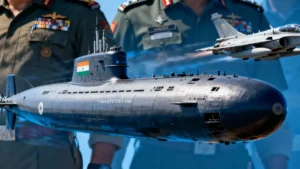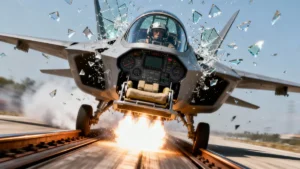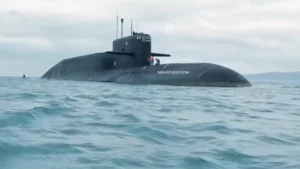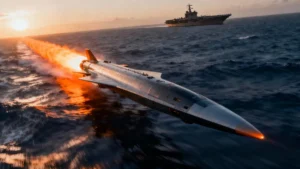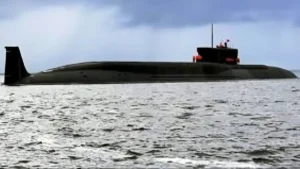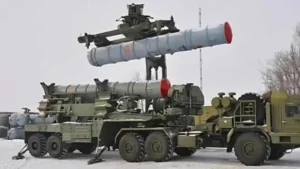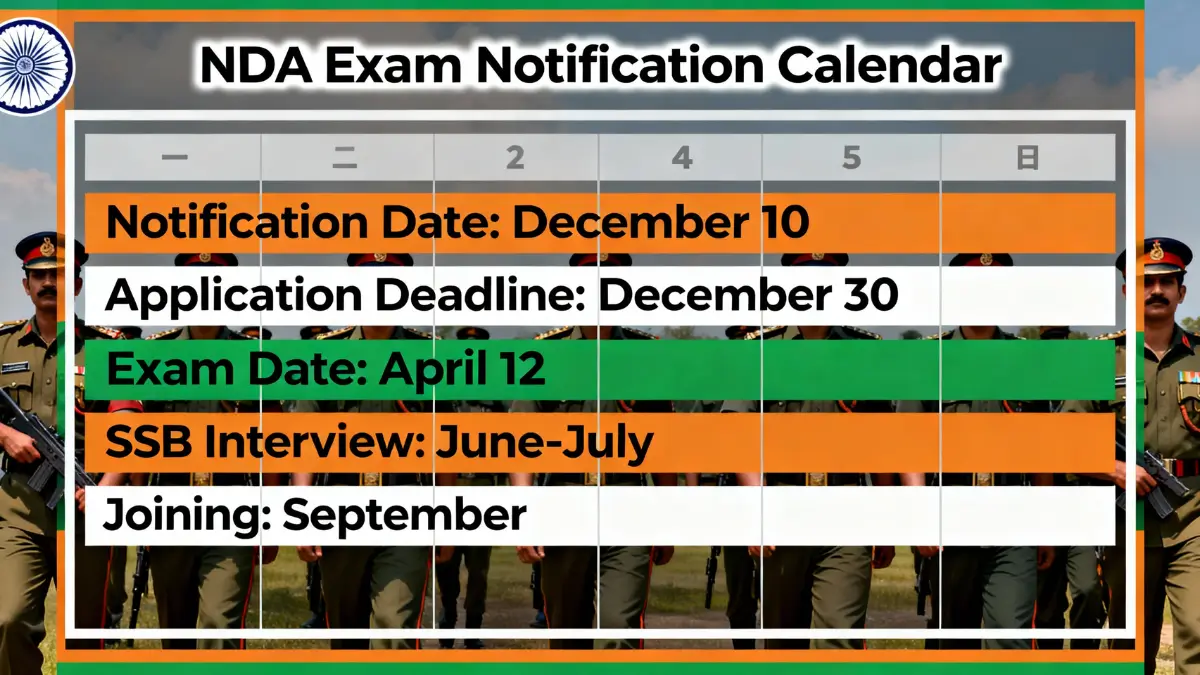Accelerating its strategic edge in space with the fast-tracked Space-Based Surveillance-III (SBS-III) project, India’s Space Force to deploy 52 military satellites by 2029. This ambitious push, driven by the success of Operation Sindoor, responds directly to growing threats from China’s expanding space militarisation. Under the stewardship of the Defence Space Agency, with satellites built by ISRO and private Indian firms, the SBS-III constellation will deliver unprecedented surveillance coverage over China, Pakistan, and the Indian Ocean Region.
Equipped with advanced Synthetic Aperture Radar (SAR), AI-powered analytics, and rapid revisit capabilities, these satellites will provide persistent, real-time intelligence and battlefield awareness to all branches of India’s military. As India’s space force prepares for 2025 and beyond, the critical question arises: how will space dominance through this satellite fleet transform India’s defence capabilities and reshape regional security dynamics? This leap marks a new chapter in India’s military evolution and underscores the strategic urgency embedded in the India military satellites space force 2025 initiative.
SBS-III Project and Technical Specifications
The Space-Based Surveillance-III (SBS-III) project is the cornerstone of India’s Space Force to deploy 52 Military Satellites by 2029, aimed at establishing a robust, next-generation satellite constellation for military surveillance, communication, and navigation. This ambitious program is driven by the Defence Space Agency (DSA) with strong collaboration from ISRO, DRDO, and private Indian aerospace firms. It seeks to enhance India’s real-time intelligence, early warning, and strategic command capabilities in response to growing space threats, particularly from China.
SBS-III Satellite Constellation Overview
- Satellite Types:
- Reconnaissance: High-resolution optical and Synthetic Aperture Radar (SAR) satellites for all-weather, day-night imaging of adversary installations and troop movements.
- Communication: Secure, encrypted satellites to ensure uninterrupted, jam-resistant military communications across land, sea, and air forces.
- Navigation: Precision navigation and timing satellites to improve guidance for missiles, drones, and forces deployed in remote areas.
- Launch Timelines:
- The first batch of 21 satellites built by ISRO is slated for launch beginning April 2026.
- The remaining 31 satellites are assigned to private companies under the government’s satellite manufacturing push, with the full constellation expected to be operational by the end of 2029.
- Payload Capacities & Technologies:
- Advanced payloads include AI-powered analytics, enabling satellites to autonomously identify and share data about targets among the constellation in real-time.
- Equipped with encrypted communication links and anti-jamming protocols to secure battlefield data.
- Use of modern propulsion and orbital manoeuvring systems to maintain optimal Low Earth Orbit (LEO) and Geostationary Orbit (GEO) positions.
- Orbits:
- The constellation operates across both LEO (400-600 km altitude) for detailed surveillance and GEO (~36,000 km altitude) for persistent wide-area monitoring.
Defence Space Agency’s Role and Collaborations
- The DSA leads strategic oversight, integrating satellite operations with India’s tri-service command to optimise intelligence dissemination and threat response.
- Close collaboration with ISRO ensures technical development and satellite launches remain on schedule.
- DRDO contributes to R&D on satellite payload technology, encryption, and counter-space defence capabilities.
- Partnerships with private aerospace firms accelerate satellite production and rapidly expand India’s indigenous space defence industrial base.
![[ EXCLUSIVE ] India’s Space Force to Deploy 52 Military Satellites by 2029 : SBS-III Project Accelerated 2 India’s Space Force to Deploy 52 Military Satellites by 2029 timeline by NDA Study](https://ndastudy.com/wp-content/uploads/2025/08/Indias-Space-Force-to-Deploy-52-Military-Satellites-by-2029-timeline-by-NDA-Study-1.webp)
Technical Specifications Summary (Table Form)
| Feature | Details |
|---|---|
| Total Satellites | 52 (21 by ISRO, 31 by private firms) |
| Satellite Types | Reconnaissance, Communication, Navigation |
| Orbits | Low Earth Orbit (400-600 km), Geostationary Orbit (~36,000 km) |
| Payloads | SAR, Optical Imaging, AI Analytics, Encrypted Comms |
| Launch Timeline | First launch: April 2026; Full deployment by 2029 |
| Key Technologies | AI data-sharing, anti-jamming communications, propulsion |
| Project Cost | Estimated ₹26,968 crore (~$3.4 billion) |
As the Indian Space Force prepares its cutting-edge constellation of military satellites, a crucial question emerges for aspiring defence technologists and young innovators: What innovative technological challenges can you address to enhance and sustain India's space militarisation? This includes areas such as AI analytics and secure satellite communications. This program signifies a transformative era in India's defence, presenting unprecedented opportunities in careers within space technology.
Strategic Implications and Defence Impact
The accelerated deployment of 52 military satellites under India’s Space Force to Deploy 52 Military Satellites by 2029 initiative marks a transformational shift in India’s defence posture, significantly enhancing surveillance, communication, missile tracking, and cyber defence capabilities. The increased satellite fleet, orchestrated by the Defence Space Agency (DSA), will provide persistent intelligence gathering and reconnaissance across India’s strategic borders, maritime lanes, and the wider Indo-Pacific region. This constellation’s integration of AI-driven analytics, Synthetic Aperture Radar (SAR), and encrypted communications ensures all-weather, real-time battlefield awareness—vital for coordinated multi-domain operations.
For India’s naval and air forces, these satellites will enable superior monitoring of maritime routes and airspace, critical for power projection and rapid response in the contested Indo-Pacific theatre. Enhanced missile early warning systems will improve India’s defensive and retaliatory capabilities, raising the threshold for any potential aggression.
Comparatively, China’s space militarisation efforts are more mature with a larger satellite count and advanced counter-space weapons. However, India’s focused SBS-III project and growing private sector partnerships reflect rapid catch-up, emphasising indigenous innovation and strategic autonomy. The forthcoming Indian military space doctrine is expected to formalise these capabilities, ensuring effective deployment and defence of space assets amid increasing contestation. As a defence analyst, Lt. Gen. (Retd.) Vinod Bhatia notes,
“India’s sats-based ISR [Intelligence, Surveillance, Reconnaissance] network under the DSA will be pivotal in redefining regional deterrence—it signals that space is now the ultimate battlefield.”
Lt. Gen. (Retd.) Vinod Bhatia, Defence analyst
The pressing question for India’s military and youth alike remains: Is India fully prepared for the complexities of space conflict and counter-space warfare? As space militarisation India accelerates, readiness will hinge on strategic innovation and resilient integration across domains.China Comparison: Race for Space Dominance
China’s military space dominance currently eclipses India in both the quantity and sophistication of orbital assets, presenting a formidable challenge in the race for space superiority. As part of the ongoing space militarisation efforts, India’s Space Force plans to deploy 52 military satellites by 2029 under the SBS-III project, which is an ambitious leap toward closing the gap with China’s vast space program.
Satellite Numbers and Technology
China operates approximately 150-200 military satellites, including reconnaissance, communication, navigation, and electronic intelligence (ELINT) platforms, compared to India’s projected 52 satellites under SBS-III. Chinese satellites benefit from diverse orbits—from Low Earth Orbit (LEO) to Geostationary Orbit (GEO)—with extensive AI-driven data processing, synthetic aperture radar (SAR) imaging, and thermal sensors for all-weather surveillance. India’s SBS-III constellation mirrors many of these advanced capabilities but currently trails in overall scale and network density.
Space Warfare Doctrine
China’s doctrine is marked by a mature “kill mesh” concept integrating multiple satellite nodes to enable precise real-time targeting and offensive-defensive space operations, including kinetic anti-satellite (ASAT) weapons, electronic jamming, and ground-based laser systems. India’s doctrine is evolving, focusing on resilient intelligence, surveillance, reconnaissance (ISR), and defensive counterspace capabilities, underscored by its recent successful ASAT test (Mission Shakti) and growing satellite constellation.
Key Differences and Closing the Gap
While China enjoys a numerical and doctrinal lead, India is rapidly narrowing the technological divide through accelerated SBS-III launches, greater private sector involvement, and strategic focus on indigenous technology development by the Defence Space Agency. India’s stronger emphasis on AI-enabled autonomous satellite coordination may enhance its situational awareness and response times in future space conflict scenarios.
Implications for Regional and Global Power Politics
This intensifying space rivalry amplifies the Indo-Pacific security competition, as control over orbital assets translates directly into terrestrial military advantage and deterrence credibility. China’s expansive space infrastructure supports its naval and missile operations across the Indo-Pacific, putting pressure on India to solidify an integrated space defence. The broader ramifications extend to alliances, arms race dynamics, and emerging space governance challenges.
As India’s Space Force to Deploy 52 Military Satellites by 2029 materialises, the question for defence professionals and youth is: How will this evolving space competition shape the future of Indo-China relations and regional stability? Your insights on this critical frontier of warfare matter.Future-Proofing: Long-Term View on Space Militarisation
India’s Space Force to Deploy 52 Military Satellites by 2029 embodies a bold vision for long-term space defence, underscoring the critical importance of continuous innovation and adaptive policy in this rapidly evolving domain over the next decade. As space emerges as a contested battlefield, India must sustain investments in cutting-edge technologies such as advanced propulsion, AI-enabled satellite autonomy, resilient communications, and cybersecurity defences to protect its space assets from growing threats.
Among the most significant risks are anti-satellite (ASAT) weapons—kinetic and non-kinetic means to disable satellites—and escalating cyber attacks targeting satellite command and control networks. These evolving threats demand robust countermeasures, including enhanced satellite resilience, real-time anomaly detection, and fortified space situational awareness, spearheaded by the Defence Space Agency’s strategic oversight.
Moreover, space defence cannot operate in isolation. Seamless integration across all military domains—land, sea, air, cyber, and space—is essential to ensure cohesive and coordinated national security responses. Satellites provide indispensable data streams that empower battlefield commanders, missile tracking units, and naval operations alike, reinforcing a multi-domain approach to warfare. For India’s youth and defence aspirants, this expanding frontier offers vast career opportunities in space technology, cybersecurity, AI, and satellite systems engineering, pivotal to shaping India’s strategic autonomy in space.
FAQs | India’s Space Force to Deploy 52 Military Satellites by 2029
1. What is the SBS-III project and why is it significant for India?
The Space-Based Surveillance-III (SBS-III) project is India’s flagship military satellite initiative aiming to deploy 52 advanced satellites by 2029. Spearheaded by the Defence Space Agency and developed with ISRO and private Indian firms, it enhances India’s surveillance, communication, and navigation capabilities. Accelerated after the success of Operation Sindoor and rising space threats from China, the SBS-III project marks a strategic leap in India’s space militarisation and defence readiness for 2025 and beyond.
2. How many military satellites will India deploy by 2029?
India plans to deploy a total of 52 military satellites by 2029 under the SBS-III program. Of these, 21 are built and launched by ISRO, while 31 are developed by private aerospace companies, forming a comprehensive constellation for persistent defence space coverage.
3. What advantages does India’s military satellite fleet provide?
India’s military satellite fleet offers persistent, all-weather intelligence and reconnaissance using Synthetic Aperture Radar (SAR), AI-driven analytics, and encrypted communications. This enables real-time battlefield awareness, secure military communications, faster missile tracking, and enhanced cyber defence, jointly empowering India’s Army, Navy, and Air Force.
4. How does India’s space force compare with China’s?
Although China currently operates a larger and more mature military satellite network, India’s SBS-III project represents a focused, rapidly growing effort to close the technological and strategic gap. With an emphasis on indigenous technology, AI-enabled satellite coordination, and accelerated private-sector involvement, India’s space force is poised to strengthen its position in the regional space militarisation landscape.
Author’s Word: India’s Strategic Push in Space
The accelerated Space-Based Surveillance-III (SBS-III) project, aiming to deploy 52 military satellites by 2029, marks a defining milestone in India’s strategic defence evolution. This ambitious program, catalysed by lessons from Operation Sindoor and driven by the Defence Space Agency, demonstrates India’s unwavering commitment to asserting space dominance alongside traditional land, sea, and air forces. By integrating advanced AI, synthetic aperture radar, and encrypted communications, India’s space force enhances real-time situational awareness and extends its reach across contested borders and maritime zones.
As the world’s space militarisation dynamics intensify, India’s focused effort underscores a forward-looking vision that not only strengthens national security but also inspires the youth and defence aspirants to engage deeply with this high-technology frontier. How will you contribute to shaping India’s space defence future? The journey of India’s Space Force to deploy 52 Military Satellites by 2029 illuminates the path of innovation, resilience, and strategic readiness in an era where space is truly the ultimate battleground.
Stay Tuned & Stay Connected!
![[ EXCLUSIVE ] India’s Space Force to Deploy 52 Military Satellites by 2029 : SBS-III Project Accelerated 1 India’s Space Force to Deploy 52 Military Satellites by 2029](https://ndastudy.com/wp-content/uploads/2025/08/Indias-Space-Force-to-Deploy-52-Military-Satellites-by-2029.webp)
